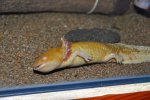Paivi
New member
- Joined
- Jul 3, 2012
- Messages
- 41
- Reaction score
- 3
- Points
- 0
- Location
- Newcastle, Australia
- Country
- Finland
First of all, thank you so much for the fantastic photo tutorial of how to fridge an axolotl! It was a great help in doing it for the first time, took a lot of anxiety out of the process :happy:
Now my question is this: how do I finish the fridge stay and get Pear back in his tank without causing too much stress on my little man? This is probably quite obvious, but I would like someone to go through that step by step as well, because when I took him out of the fridge and back into the tank last time, he got so hugely stressed, I had to put him back in after only 12 hours. I don't know if the reason was something I did wrong, or his tank mates or something else in the tank, or the fact that he simply wasn't ready, but I really do not want to repeat that experience!
This is how I did it last time.
The temperature in the fridge was 7 degrees Celcius, the tank temperature was about 19. To acclimatise him for the temperature change, I took his container out of the fridge, opened it and placed it on the table, and then we waited. I had a thermometer in the container to follow the warming of the water. We kept an eye on him, but didn't disturbe him in anyway, and kept the lights dim in the room.
Once the temperature got closer to the tank temperature (it too several hours, without any artificial help), we floated the container in the tank to even out the remaining temperature difference. Once the temperature was the same, we released him in the tank. The tank lights were turned off all this time, and there was only a small spot light on in the room, near the tank though.
Thinking back, I don't think he was very happy about the floating part. And he didn't look good when he got into the tank, didn't eat, and in the morning he looked just awful. I actually thought he had eaten gravel or something! The photos of him are in another thread here on this sub-forum.
So he went back into the fridge that very morning! And it seems to have worked, as he looks good now. No stress signs visible anymore, he is active when I pull his container out of the fridge to check on him and to change his water, his body feels good and strong. He is a bit thin, but not overly so. To be expected, I suppose, after not eating for over 2 weeks!
So he is looking all better, and I would like to get him back into his tank in the next day or two, (also because we have to go away for a week next week, and if there is any issues still with him, I'd rather find out sooner rather than later so I can still do something about it!) BUT I do want to do it right. So if someone could please tell me what did I do wrong last time, and how to do it right this time, I would very much appreciate it, and Pear would too, I'm sure! :happy:
Also, can I suggest that the process of ending the fridging would be added to the fridging tutorial, or as a separate one, as I'm sure I'm not the only one who is unsure of things while doing them for the first time! It might be obvious and self-explanatory to most, but if it's your first axolotl and you don't know too much about them, then even the self-explanatory is not that obvious! As a dance instructor I'm reminded about that in almost every class; what's obvious to me after over 20 years of practice is not so for someone with less experience.
Thank very much for your help!
Now my question is this: how do I finish the fridge stay and get Pear back in his tank without causing too much stress on my little man? This is probably quite obvious, but I would like someone to go through that step by step as well, because when I took him out of the fridge and back into the tank last time, he got so hugely stressed, I had to put him back in after only 12 hours. I don't know if the reason was something I did wrong, or his tank mates or something else in the tank, or the fact that he simply wasn't ready, but I really do not want to repeat that experience!
This is how I did it last time.
The temperature in the fridge was 7 degrees Celcius, the tank temperature was about 19. To acclimatise him for the temperature change, I took his container out of the fridge, opened it and placed it on the table, and then we waited. I had a thermometer in the container to follow the warming of the water. We kept an eye on him, but didn't disturbe him in anyway, and kept the lights dim in the room.
Once the temperature got closer to the tank temperature (it too several hours, without any artificial help), we floated the container in the tank to even out the remaining temperature difference. Once the temperature was the same, we released him in the tank. The tank lights were turned off all this time, and there was only a small spot light on in the room, near the tank though.
Thinking back, I don't think he was very happy about the floating part. And he didn't look good when he got into the tank, didn't eat, and in the morning he looked just awful. I actually thought he had eaten gravel or something! The photos of him are in another thread here on this sub-forum.
So he went back into the fridge that very morning! And it seems to have worked, as he looks good now. No stress signs visible anymore, he is active when I pull his container out of the fridge to check on him and to change his water, his body feels good and strong. He is a bit thin, but not overly so. To be expected, I suppose, after not eating for over 2 weeks!
So he is looking all better, and I would like to get him back into his tank in the next day or two, (also because we have to go away for a week next week, and if there is any issues still with him, I'd rather find out sooner rather than later so I can still do something about it!) BUT I do want to do it right. So if someone could please tell me what did I do wrong last time, and how to do it right this time, I would very much appreciate it, and Pear would too, I'm sure! :happy:
Also, can I suggest that the process of ending the fridging would be added to the fridging tutorial, or as a separate one, as I'm sure I'm not the only one who is unsure of things while doing them for the first time! It might be obvious and self-explanatory to most, but if it's your first axolotl and you don't know too much about them, then even the self-explanatory is not that obvious! As a dance instructor I'm reminded about that in almost every class; what's obvious to me after over 20 years of practice is not so for someone with less experience.
Thank very much for your help!




